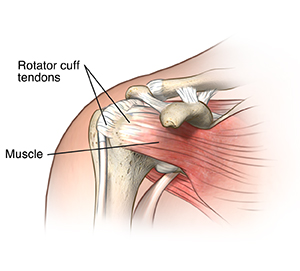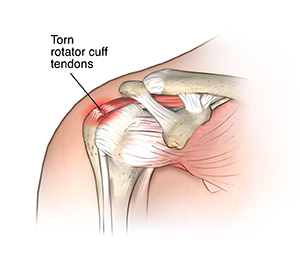A
B
C
D
E
F
G
H
I
J
K
L
M
N
O
P
Q
R
S
T
U
V
W
X
Y
Z
Topic IndexLibrary Index
Click a letter to see a list of conditions beginning with that letter.
Click 'Topic Index' to return to the index for the current topic.
Click 'Library Index' to return to the listing of all topics.
Rotator Cuff Injury
What is a rotator cuff injury?
Your rotator cuff consists of muscles and tendons that hold your shoulder in place. It's one of the most important parts of your shoulder.
Your rotator cuff allows you to lift your arms and reach up. Each year, millions of people in the U.S. go to their healthcare providers because of a rotator cuff problem. A rotator cuff tear is a common cause of pain and disability among adults.


What causes a rotator cuff injury?
Injury and degeneration are the two main causes of rotator cuff tears. An injury to the rotator cuff, such as a tear, may happen suddenly when falling on an outstretched hand. It may also develop over time due to repetitive activities. Rotator cuff tears can also happen due to the breakdown (degeneration) of the tissues, which may happen as part of the aging process.
What are the symptoms of rotator cuff tear?
Symptoms may be a bit different for each person. Symptoms may include:
-
Pain that keeps coming back, especially when doing certain things, such as lifting over your head
-
Pain that prevents you from sleeping on your injured side
-
Grating or cracking sounds when moving your arm
-
Limited ability to move your arm
-
Muscle weakness
The symptoms of a rotator cuff tear may be caused by other conditions or health problems. Always talk with your healthcare provider for a diagnosis.
How is a rotator cuff injury diagnosed?
Your healthcare provider will take a complete health history and do a physical exam. You may also have diagnostic tests, such as:
-
X-ray. This test uses invisible electromagnetic energy beams to make images of internal tissues, bones, and organs on film.
-
MRI. This test uses a combination of large magnets, radiofrequencies, and a computer to make detailed images of organs and structures within the body.
A rotator cuff may tear partly or fully.
How is a rotator cuff injury treated?
Treatment will depend on your symptoms, age, and general health. It'll also depend on how bad the condition is.
Treatment may include:
-
Rest
-
Nonsteroidal anti-inflammatory drugs
-
Strengthening and stretching exercises
-
Ultrasound therapy
-
Corticosteroid shot (injection)
-
Surgery for severe injuries or tears
When should I call my healthcare provider?
Call your provider if:
Key points about rotator cuff injury
-
Your rotator cuff is one of the most important parts of your shoulder. It allows you to lift your arms and reach up.
-
Injury and breakdown (degeneration) are the two main causes of rotator cuff tears.
-
Symptoms may include pain that keeps coming back, muscle weakness, limited ability to move your arm, and grating or cracking sounds when moving your arm.
-
Treatment may include rest, medicine, strengthening and stretching exercises, and surgery.
-
Call your healthcare provider if pain gets worse or you can't use your arm like you used to.
Next steps
Tips to help you get the most from a visit to your healthcare provider:
-
Know the reason for your visit and what you want to happen.
-
Before your visit, write down questions you want answered.
-
Bring someone with you to help you ask questions and remember what your provider tells you.
-
At the visit, write down the name of a new diagnosis and any new medicines, treatments, or tests. Also write down any new instructions your provider gives you.
-
Know why a new medicine or treatment is prescribed and how it will help you. Also know what the side effects are and when they should be reported.
-
Ask if your condition can be treated in other ways.
-
Know why a test or procedure is recommended and what the results could mean.
-
Know what to expect if you don't take the medicine or have the test or procedure.
-
If you have a follow-up appointment, write down the date, time, and purpose for that visit.
-
Know how you can contact your healthcare provider if you have questions, especially after office hours or on weekends and holidays.
Online Medical Reviewer:
Raymond Turley Jr PA-C
Online Medical Reviewer:
Rita Sather RN
Online Medical Reviewer:
Thomas N Joseph MD
Date Last Reviewed:
9/1/2023
© 2000-2025 The StayWell Company, LLC. All rights reserved. This information is not intended as a substitute for professional medical care. Always follow your healthcare professional's instructions.